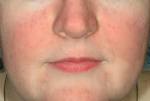Skin Rash After Surgery Biography
Source(google.com.pk)surgery that causes a break in the skin can lead to a rash.
Signs and symptoms:
1. It may produce puss, which doctors call "purulent discharge," from the wound site. Samples of the pus may be grown in a culture to find out the types of germs that are causing the rash.
2. The wound site may reopen on its own, or a surgeon may reopen the wound and find purulent discharge inside the wound.
3. An organ may show a discharge of pus coming from a drain placed through the skin into a body space or organ. A collection of purulent discharge called an abscess is an enclosed area of pus and disintegrating tissue surrounded by inflammation. An abscess may be seen when the surgeon reopens the wound or by special X-ray studies.
Causes and risk factors:
Rashes after surgery are caused by germs called microorganisms. The most common of these include the bacteria Staphylococcus, Streptococcus, and Pseudomonas. Microorganisms can infect a surgical wound through various forms of contact, such as from the touch of a contaminated caregiver or surgical instrument, through microorganisms in the air, or through microorganisms that are already on or in your body and then spread into the wound.
Surgical wounds can be classified in this way:
Clean wounds. These are not inflamed or contaminated and do not involve operating on an internal organ; the risk for an SSI in this type of wound is less than 2 percent.
Clean-contaminated wounds. These have no evidence of infection at the time of surgery, but do involve operating on an internal organ; the risk for SSI is less than 10 percent.
Contaminated wounds. These involve operating on an internal organ with a spilling of contents from the organ into the wound; the risk for SSI is 13 to 20 percent.
Dirty wounds. These are wounds in which a known infection is present at the time of the surgery; the risk for SSI is about 40 percent.
These are other risk factors:
1.Surgery that lasts more than two hours
2.Having other medical problems or diseases
3.Being an elderly adult
4.Being overweight
5.Smoking
6.Having cancer
7.Having a weakened immune system
8.Having diabetes
9.Having emergency surgery
10.Having abdominal surgery
Helping prevent:
If you are having surgery, ask your doctor what you can do to reduce your risk for a surgical site rash. It's important to stop smoking before surgery and to tell your surgical team about your medical history, especially if you have diabetes or another chronic illness. Also, avoid shaving in the skin area that the surgeon is planning to operate through.
No matter how curious they are, loved ones should not touch your wound or surgical site. Carefully follow your doctor's instructions about wound care after surgery. Call your doctor if you develop a fever or pus, redness, heat, pain and/or tenderness near the wound or any other signs or symptoms of a surgical site rashes.
Treatment:
Most rashes after surgery can be treated with antibiotic medications. Sometimes additional surgery or procedures may be required to treat the rashes. During recovery, make sure that friends and family members wash their hands before and after they enter your room—and make sure doctors, nurses, and other caregivers wash their hands, too.
Skin Rash After Surgery Skin Rashes In Children On Face In Adults On Hands On Arms That Itch In Kids On Dogs On Chest On Neck

Skin Rash After Surgery Skin Rashes In Children On Face In Adults On Hands On Arms That Itch In Kids On Dogs On Chest On Neck

Skin Rash After Surgery Skin Rashes In Children On Face In Adults On Hands On Arms That Itch In Kids On Dogs On Chest On Neck

Skin Rash After Surgery Skin Rashes In Children On Face In Adults On Hands On Arms That Itch In Kids On Dogs On Chest On Neck

Skin Rash After Surgery Skin Rashes In Children On Face In Adults On Hands On Arms That Itch In Kids On Dogs On Chest On Neck

Skin Rash After Surgery Skin Rashes In Children On Face In Adults On Hands On Arms That Itch In Kids On Dogs On Chest On Neck

Skin Rash After Surgery Skin Rashes In Children On Face In Adults On Hands On Arms That Itch In Kids On Dogs On Chest On Neck

Skin Rash After Surgery Skin Rashes In Children On Face In Adults On Hands On Arms That Itch In Kids On Dogs On Chest On Neck

Skin Rash After Surgery Skin Rashes In Children On Face In Adults On Hands On Arms That Itch In Kids On Dogs On Chest On Neck
Skin Rash After Surgery Skin Rashes In Children On Face In Adults On Hands On Arms That Itch In Kids On Dogs On Chest On Neck
Skin Rash After Surgery Skin Rashes In Children On Face In Adults On Hands On Arms That Itch In Kids On Dogs On Chest On Neck
Skin Rash After Surgery Skin Rashes In Children On Face In Adults On Hands On Arms That Itch In Kids On Dogs On Chest On Neck
Skin Rash After Surgery Skin Rashes In Children On Face In Adults On Hands On Arms That Itch In Kids On Dogs On Chest On Neck
Skin Rash After Surgery Skin Rashes In Children On Face In Adults On Hands On Arms That Itch In Kids On Dogs On Chest On Neck
Skin Rash After Surgery Skin Rashes In Children On Face In Adults On Hands On Arms That Itch In Kids On Dogs On Chest On Neck
Skin Rash After Surgery Skin Rashes In Children On Face In Adults On Hands On Arms That Itch In Kids On Dogs On Chest On Neck
Skin Rash After Surgery Skin Rashes In Children On Face In Adults On Hands On Arms That Itch In Kids On Dogs On Chest On Neck
your tips are very useful. thanks for posting.
ReplyDeleteskin doctor in bangalore